South China
-
- South China Sea Arbitration: Implications for Maritime and O&G Maritime Reporter, Oct 2016 #14
A recent decision by an international tribunal in The Hague, Netherlands, has significant implications for other maritime disputes, freedom of navigation, and future oil and gas claims in the Arctic.
The arbitral award issued on July 12, 2016, by a unanimous five-member panel or Permanent Court of Arbitration (PCA) in the dispute between the Philippines and China over rocks and elevations in the South China Sea, sounded a clarion call for the rule of law and the clearly defined maritime boundaries and environmental principles established by the United Nations Convention on Law of the Sea (Convention). It remains to be seen whether China will abide by the decision and enter into negotiations with the Philippines to resolve all remaining disputes to these territories and waters. To date, China, which never participated or recognized the authority of the PCA to arbitrate this case, has rejected the ruling and is continuing to build up its military presence in the region.The DisputeBoth the Philippines and China are parties to the Convention, which requires that parties to maritime disputes resolve them through arbitration. The dispute essentially revolved around China’s drawing of a so-called “nine-dash-line” around several outcroppings in the South China Sea that borders both China and the Philippines. China claimed that it had historical rights to these outcroppings and that no tribunal under the Convention could rule on its alleged sovereignty to this territory. Tired of having their fishermen harassed in open waters, and their vessels being harassed by Chinese law enforcement vessels, in 2013, the Philippines brought this dispute to the Hague in claiming that China was interfering with traditional Philippine fishing activities at Scarborough Shoal, an island in the South China Sea; that China had no “historic rights” with respect to the maritime areas of the South China Sea; that China had violated its duties under the Convention to protect and preserve the marine environment; that China had breached its obligations under the Convention by operating its law enforcement vessels in a dangerous manner causing serious risk of collision to Philippine vessels navigating in the vicinity; and that the reefs that China had claimed as low-tide elevations did not generate any entitlement to an exclusive economic zone or continental shelf. The Philippines were well-represented by a team of skilled U.S. lawyers, while China refused to attend or participate in the PCA’s deliberations because of its position that the tribunal could not rule on matters of sovereignty, which China claimed over all islands and reefs in the South China Sea, including the Spratly Islands and Scarborough Shoal. [See map left.]The RulingThe PCA first had to determine whether it had jurisdiction to hear the dispute. The PCA found that it did so because the dispute was not over territorial sovereignty—over which they admittedly had no jurisdiction—but was a dispute under the Convention over maritime boundaries and protection of the marine environment.The PCA turned next to the merits of the case and found that China’s claim to historic rights to resources and waters of the South China Sea was fundamentally incompatible with the allocation of rights and establishment of maritime zones in the Convention. Significantly, if China had any historic rights to resources and waters of the South China Sea, these rights were extinguished by the entry into force of the Convention and were incompatible with the Convention’s system of maritime zones, i.e., 12-mile territorial seas, and 200-mile Exclusive Economic Zones (EEZ). As a party to the Convention, China has accepted these boundaries.The next question was whether the outcroppings in the South China Sea were entitled to a territorial sea or EEZ. The PCA found that certain reefs were above water at high tide; therefore they were entitled to a 12-mile territorial sea. However, other outcroppings claimed by China as having their own EEZ—encircled by the nine-dash-line—did not because they could not sustain human habitation or economic life on their own, despite China’s efforts to place runways and other buildings on these islands. Although Chinese and other fishermen had used the Spratly Islands, this temporary usage did not amount to habitation by a stable community and therefore these features are just “rocks” that do not generate an EEZ or continental shelf. Finally, the Tribunal concluded that China had violated its duty to respect the traditional fishing rights of Philippine fishermen by halting their access to Scarborough Shoal after May 2012, and that its large-scale land reclamation and construction of artificial islands at seven features in the Spratly Islands had caused severe harm to the coral reef environment, thus violating China’s obligations under the Convention to preserve and protect the marine environment. Regrettably, the PCA cannot enforce its award so it is up to China to decide how to react. So far, the reaction has been fairly negative and China is continuing to operate patrols there, sending its aircraft to the Spratly Islands, and once again using Chinese coast guard ships to block access by Philippine fishermen to the Scarborough Shoal.Implications for U.S. Shipping and O&G Exploration in the ArcticAn estimated $5.3 trillion of maritime commerce passes through the South China Sea every year as a major shipping route between China, Japan, South Korea, Europe, and the Middle East. Should China choose to impede the rights of innocent passage and freedom of safe navigation, according to Esben Poulsson, President of the Singapore Shipping Association, this “would potentially drive up shipping costs, resulting in a detrimental impact on maritime trade.”Although no U.S.-flag vessel has been harassed to date by Chinese vessels, the United States is taking no chances and is sending its own ships to patrol the open waters of the South China Sea. On August 6, amphibious assault ship USS Boxer completed a routine patrol in international waters of the South China Sea in order to “help promote the rights, freedoms, and lawful uses of the sea and airspace guaranteed to all countries,” according to Captain Patrick Foege, commander of U.S. Navy Amphibious Squadron 1. Some Members of Congress, including Senator Dan Sullivan (R-AK), are calling on the United States to send two aircraft carriers there on a permanent basis to protect the fundamental right enshrined in the Declaration of Independence of freedom of navigation. (From a keynote speech of Senator Sullivan on July 12, 2016, at the 6th Annual South China Sea Conference of the Center for Strategic and International Studies.)Impacts of the Ruling on Other ClaimsNow that the PCA has made clear the obligation of parties to the Convention to abide by its principles and boundaries, it is more important than ever for the United States to ratify the Convention, which creates not only a 200-mile EEZ but also an extended continental shelf out to 350 miles. This is critical if the United States wants to protect its claims to the vast oil and gas resources of the outer Continental Shelf (OCS) in the Arctic and counter claims of other nations, e.g., Russia, that may interfere with its own claims based on the U.S.-extended continental shelf adjacent to Alaska.Russia and more than fifty other nations have staked their claims to an extended OCS by filing submissions to the Commission on the Limits of the Continental Shelf pursuant to Article 76 of the Convention. The United Nations was prepared to consider Russia’s claims this summer during the Commission’s 41st session. The United States is an observer at the Commission proceedings, but since it is not a party to the Convention, it has no official role there. While the United States can claim to and does abide by maritime principles under the Convention as a matter of customary international law, it will have better standing in the world to protect its own and other countries’ legitimate maritime boundaries and encourage China to abide by the rule of law if the United States is itself a party to the Convention.Oil and gas companies and their respective trade associations and many other groups have long urged the United States to ratify the Convention; it is time for the Senate to quickly and responsibly do so.The benefits of ratification clearly outweigh any perceived costs.
The AuthorJoan Bondareff, Of Counsel at Blank Rome LLP, focuses her practice on marine transportation, environmental, and legislative issues and represents clients in many industries and state and local governments. -
- Opinion: Maritime Freedom & the Global Commons Maritime Reporter, Mar 2020 #72
Qatar, passing through the Strait of Hormuz each year. 3Likewise, China’s attempts to rationalize and assert control of 80 to 90 percent of the South China Sea, including waters allocated to neighboring sovereign states under the U.N. Convention on the Law of the Sea (UNCLOS) are equally troubling.
-
- U.S. Navy Asserts “Freedom of Navigation” in the South China Sea Maritime Reporter, Aug 2021 #16
in the western Pacific, where the United States Navy continues to assert its right to operate freely in international waters by conducting FONOPS in the South China Sea, particularly in the vicinity of the Spratly and Paracel Islands. USS Benfold (DDG 65) conducted a FONOP in the South China Sea on July
-
- South China Yard Holds Court In Pearl River Delta Maritime Reporter, Aug 2002 #22
Located at Tanzhou Port in the Pearl River delta area near Panyu, the Yuexin Shipyard is a typically busy south China building yard. Projects include a pair of large offshore supply vessels that are coming together at the same time as sheet metal is being attached to the bright blue framing of huge new
-
- Choke Points are Flash Points Maritime Reporter, Sep 2016 #28
. Disputed sovereignty claims and efforts to enforce them have the maritime world on edge. China’s nine-dash line claims about owning the entire East and South China Sea have created a dilemma for themselves and the other nations in the region. The Philippines v. China case with the Permanent Court of Arbitration
-
- Amoco, China Sign Joint Agreement To Undertake $500 Million Oil Project Maritime Reporter, Mar 1991 #47
A joint-venture agreement between Amoco Corp and China was recently signed to develop an oil field in the South China Sea. The project is expected to cost around $500 million and produce 50,000 barrels of oil a day, a spokesman for the company said. Amoco's chairman and chief executive officer
-
- Hydranautics Receives BOP Skidding Contract For Sedco 600, 601, 602 Maritime Reporter, Jan 4, 1982 #10
, the first of their kind for Sedco, are being built by Promet Pte., Ltd. of Singapore. Sedco 600 is contracted to Sedco Energy Corp. for work in the South China Sea. Sedco 601 is contracted to Union Oil. Sedco 601 is contracted to Occidental
-
- Congress: Short-term Funding Decisions Create Long-term Domestic and National Security Issues Marine News, Sep 2022 #19
across Oceana and the Indo Pacific. For example, only five years after an international court ruling that rejected 90% of Beijing's claims in the South China Sea, the presence of Chinese vessels within the Philippines’ Exclusive Economic Zone is more frequent than ever. China has also continued
-
- WFS seatooth S100 Marine Technology, May 2014 #47
systems to Baker Hughes. WFS supplied a seatooth S100 system for wireless datalogging during pipeline pre-commissioning on a project in the South China Sea at water depth of 1,000m. The transmitter comprised a seatooth S100 connected to a hydrotest skid and the receiver comprised a seatooth S100
-
- Shipping Losses Lowest This Century as New Dangers Emerge Maritime Logistics Professional, May/Jun 2019 #45
collecting all this data, but how are we using it? Are we really using it in the predictive model?”Worst accident locations and common causes of lossThe South China, Indochina, Indonesia and Philippines maritime region remains the top loss location. One in four occurred here in 2018 (12), although this is significant
-
- Promet Gets $60-Million Order For Drill Rig For Sedco Incorporated Maritime Reporter, Jun 15, 1981 #44
for Sedco Incorporated, an international drilling company based in Dallas, and will be used in West Africa, South America, Gulf of Mexico, and South China Sea. To be named Sedco 600, the semisubmersible measures 170 feet by 170 feet by 90 feet and has a drilling capacity of 20,000 feet in 600
-
- Boeing Sells $13.7-Million Jetfoil To Indonesia Maritime Reporter, Mar 15, 1981 #48
, ocean resource control and commercial passenger transportation. Initial plans call for the Jetfoil to be used for customs enforcement in the South China Sea. The water jet-propelled Jetfoil is capable of speeds over 50 miles per hour, and provides a smooth ride even in rough water. Equipped
-
 )
March 2024 - Marine Technology Reporter page: 48
)
March 2024 - Marine Technology Reporter page: 48. . .Silicon Sensing Systems Limited . . . . . . . . . .www.siliconsensing.com . . . . . . . . . . . . . . . . . . . . . . .+44 (0) 1752 723330 13 . . . . .South Bay Cable Corp . . . . . . . . . . . . . . . . . .www.southbaycable.com . . . . . . . . . . . . . . . . . . . . . . . . . . . .(951) 659-2183 27 .
-
 )
March 2024 - Marine Technology Reporter page: 45
)
March 2024 - Marine Technology Reporter page: 45(MBES), allows Unique to boost its subsea equipment rental pool. The order will swell the capacity of Unique’s Singapore base, giving customers in South East Asia fresh access to the calibration free µPAP SSBL sys- tems and the lightweight, robust and user-friendly EM2042, globaloceandesign.com launched
-
 )
March 2024 - Marine Technology Reporter page: 26
)
March 2024 - Marine Technology Reporter page: 26FEATURE OCEANOGRAPHIC INSTRUMENTATION & SENSORS Kevin Mackay, TESMaP voyage leader and Center head of the South and West Paci? c Regional Centre of Seabed 2030. Kevin in the seismic lab at Greta Point looking at the Hunga Tonga-Hunga Ha’apai volcano 3D map completed with data from the TESMaP voyage
-
 )
April 2024 - Maritime Reporter and Engineering News page: 38
)
April 2024 - Maritime Reporter and Engineering News page: 38, Copan, Tiscapa and Torogoz. The 1,400 TEU ves- sels were ordered in 2022 by Singapore-based Eastern Paci? c Shipping (EPS) for scheduled delivery from South Korea’s Hyundai Mipo Dockyard in 2025. EPS will charter the ships out to Crowley, who will deploy them on its U.S.-Central America trade connecting
-
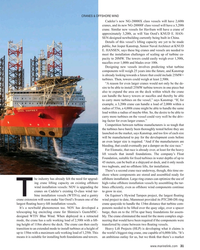 )
April 2024 - Maritime Reporter and Engineering News page: 31
)
April 2024 - Maritime Reporter and Engineering News page: 31CRANES & OFFSHORE WIND Cadeler’s new NG-20000X class vessels will have 2,600t cranes, and its new NG-20000F class vessel will have a 3,200t crane. Similar new vessels for Havfram will have a crane of approximately 3,200t, as will Van Oord’s KNUD E. HAN- SEN-designed newbuilding currently being built in
-
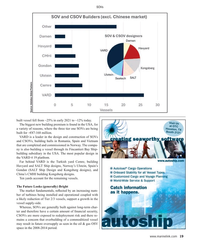 )
April 2024 - Maritime Reporter and Engineering News page: 19
)
April 2024 - Maritime Reporter and Engineering News page: 19SOVs Source: Intelatus Global Partners built vessel fell from ~25% in early 2021 to ~12% today. Visit Us The biggest new building premium is found in the USA, for at OTC Houston, TX a variety of reasons, where the three tier one SOVs are being Booth 2121 built for ~€87-168 million. VARD is a leader in
-
 )
April 2024 - Maritime Reporter and Engineering News page: 18
)
April 2024 - Maritime Reporter and Engineering News page: 18gas offshore support vessels have been widely nol is a preferred energy carrier although hydrogen and liquid deployed to support construction logistics. South Korea, Ja- organic hydrogen carriers also feature. pan and, in the longer-term, Vietnam and Australia, are fore- Battery energy storage systems feature
-
 )
April 2024 - Maritime Reporter and Engineering News page: 17
)
April 2024 - Maritime Reporter and Engineering News page: 17SOVs China, we do not look at demand for SOVs/CSOVs as having a linear rela- tionship to the number of wind farms or turbines installed. We look to see where a large number of wind turbines are concentrated in relatively close proximity, generally in a very large wind farm or in a project cluster
-
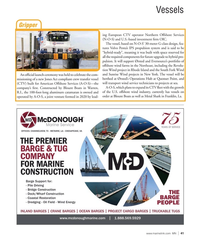 )
April 2024 - Marine News page: 41
)
April 2024 - Marine News page: 41Eversource’s portfolio of offshore wind farms in the Northeast, including the Revolu- American Offshore Services tion Wind project in Rhode Island and the South Fork Wind and Sunrise Wind projects in New York. The vessel will be An of? cial launch ceremony was held to celebrate the com- missioning of a new
-
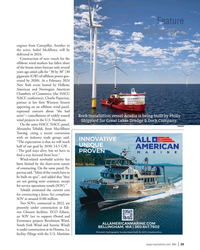 )
April 2024 - Marine News page: 29
)
April 2024 - Marine News page: 29, are presently under construction at Edi- son Chouest facilities. ECO Edison, an SOV (set to support Ørsted and Eversource projects Revolution Wind, South Fork Wind and Sunrise Wind) is under construction at its Houma, La. facility. Filings with the U.S. Maritime www.marinelink.com MN 29
-
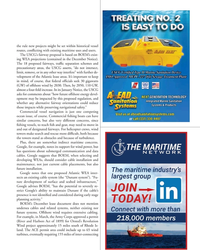 )
April 2024 - Marine News page: 23
)
April 2024 - Marine News page: 23, in March, the Army Corps approved a permit 218,000 members (River and Harbors Act of 1899) for Orsted’s Revolution Wind project approximately 15 miles south of Rhode Is- land. The ACE permit area could include up to 65 wind turbines, eventually requiring 155 miles of inter-connecting
-
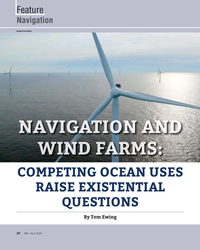 )
April 2024 - Marine News page: 20
)
April 2024 - Marine News page: 20Feature Navigation South Fork Wind COMPETING OCEAN USES RAISE EXISTENTIAL QUESTIONS By Tom Ewing 20 | MN April 2024
-
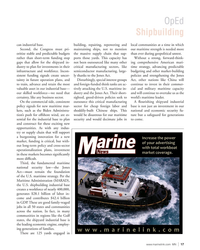 )
April 2024 - Marine News page: 17
)
April 2024 - Marine News page: 17OpEd Shipbuilding can industrial base. building, repairing, repowering and local communities at a time in which Second, the Congress must pri- maintaining ships, not to mention our maritime strength is needed more oritize stable and predictable budgets the massive supply chain that sup- than ever
-
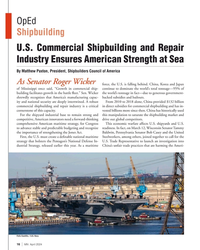 )
April 2024 - Marine News page: 16
)
April 2024 - Marine News page: 16OpEd Shipbuilding U.S. Commercial Shipbuilding and Repair Industry Ensures American Strength at Sea By Matthew Paxton, President, Shipbuilders Council of America As Senator Roger Wicker force, the U.S. is falling behind. China, Korea and Japan of Mississippi once said, “Growth in commercial ship-
-
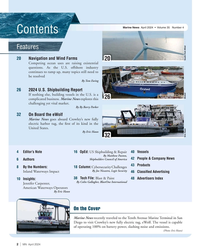 )
April 2024 - Marine News page: 2
)
April 2024 - Marine News page: 2the eWolf Marine News goes aboard Crowley’s new fully electric harbor tug, the ? rst of its kind in the United States. By Eric Haun Eric Haun Ørsted South Fork Wind 32 4 Editor’s Note 16 OpEd: US Shipbuilding & Repair 40 Vessels By Matthew Paxton, 42 People & Company News Shipbuilders Council
-
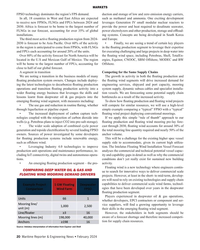 )
February 2024 - Maritime Reporter and Engineering News page: 20
)
February 2024 - Maritime Reporter and Engineering News page: 20for over 35% of global power electrolyzers and other production, storage and of? oad- installations. ing systems. Concepts are being developed in South Korea The third most active ? oating production region from 2024- and Europe. 2030 is forecast to be Asia Paci? c. Over 60% of the activity • Finally
-
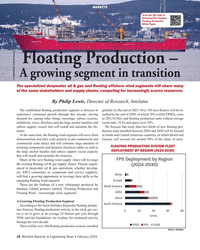 )
February 2024 - Maritime Reporter and Engineering News page: 18
)
February 2024 - Maritime Reporter and Engineering News page: 18of new ? oating pro- ments. duction units installed between 2024 and 2030 will be located At the same time, the ? oating wind segment will move from in South and Central American countries, of which Brazil and demonstration and pilot scale projects to pre-commercial and Guyana will account for around 90%
-
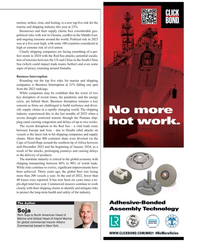 )
February 2024 - Maritime Reporter and Engineering News page: 13
)
February 2024 - Maritime Reporter and Engineering News page: 13companies are facing something of a per- fect storm in 2024 with the Red Sea attacks, potential escala- tion of tensions between the US and China in the South China Sea (which could impact trade routes further) and even some signs of piracy returning around Somalia. Business Interruption Rounding out the top
-
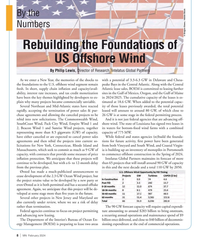 )
February 2024 - Marine News page: 8
)
February 2024 - Marine News page: 8stage in the federal permitting process. rebid into new solicitations. The Commonwealth Wind, And it is not just federal agencies that are advancing off- SouthCoast Wind, Pack City Wind, Empire Wind 1 and shore wind. The state of Louisiana has signed two leases in 2, Beacon Wind 1 and Sunrise Wind projects
-
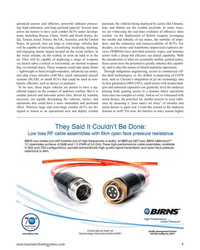 )
January 2024 - Marine Technology Reporter page: 9
)
January 2024 - Marine Technology Reporter page: 9are known to have such combat AUVs under develop- we are witnessing the real-time evolution of offensive mine ment, including Russia, China, North and South Korea, In- warfare via the deployment of hybrid weapons leveraging dia, Taiwan, Israel, France, the UK, Australia, and the United the stealth and
-
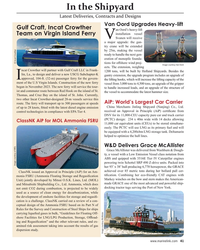 )
January 2024 - Maritime Reporter and Engineering News page: 41
)
January 2024 - Maritime Reporter and Engineering News page: 41In the Shipyard Latest Deliveries, Contracts and Designs Van Oord Upgrades Heavy-lift Gulf Craft, Incat Crowther an Oord’s heavy-lift installation vessel Team on Virgin Island Ferry VSvanen will receive a major upgrade: the gan- try crane will be extended by 25m, making the vessel ready to handle the
-
 )
January 2024 - Maritime Reporter and Engineering News page: 40
)
January 2024 - Maritime Reporter and Engineering News page: 40In the Shipyard Latest Deliveries, Contracts and Designs Vard Inks $450M to Build Cable Layers ARD won a $252m contract for the design and con- struction of a third cable laying vessel for Italy’s Prysmian Group: Monna Lisa is still under construc- V tion; Leonardo da Vinci was delivered in 2021. The new
-
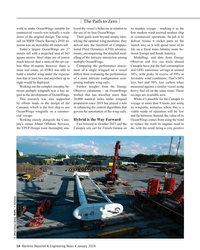 )
January 2024 - Maritime Reporter and Engineering News page: 14
)
January 2024 - Maritime Reporter and Engineering News page: 14(CFD) advance- life on a ? xed trans-Atlantic route be- meters tall with a projected area of 363 ments, encompassing the detailed mod- tween Europe and South America. square meters. Steel ships are of course elling of the intricate interaction among Modelling, and data from Energy much heavier than a
-
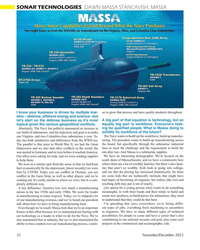 )
November 2023 - Marine Technology Reporter page: 32
)
November 2023 - Marine Technology Reporter page: 32submarine supplier. Our allies were asking for help, and we were sending supplies We have an interesting demographic. We’re located on the to help them. south shore of Massachusetts, and we have a community here We were in a similar spot from the sense in that we had been where there are a lot of wealthy
